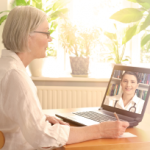NEW YORK (Reuters Health)—The COVID-19 pandemic has accelerated the expansion of telemedicine across the U.S., which has opened up access to doctor’s offices for families with limited resources. But at the same time, the health disparity gap could continue to widen unless safeguards are put into place, according to a pair of new editorials.
“There are countless historical examples of new scientific advances not reaching the folks who stand to benefit the most, resulting in better health outcomes only for those with the resources to access them, and consequently, widening health disparities,” says Michelle Katzow, MD, of Northwell Health in New Hyde Park, New York, a coauthor of one of the pieces, both published in Pediatrics.1
“But this is not an inevitable outcome,” she tells Reuters Health by email. “We believe that this moment may be an opportunity to get it right, if appropriate precautions are taken.”
Dr. Katzow and colleagues write about the recent trends in telemedicine and the barriers that could further deepen the health inequities that exist. In their general pediatrics practice, for instance, the team has used telemedicine to provide newborn follow-up visits, developmental screenings, nutrition counseling, asthma management, behavioral health and care for children who are medically fragile.
Although 80% of U.S. adults have access to a smartphone and 75% have access to broadband internet at home, not everyone does, they note.
In one instance, a mother of a toddler called the office and reported that he was vomiting up blood. He has a complex chronic illness, and before the pandemic, the doctors would have directed her to go to the emergency department immediately.
Due to the risk of COVID-19 infection, though, they scheduled a telemedicine visit. The mother didn’t speak English and didn’t have a smartphone, data plan or email address. She had a free chat application on her mobile device, and the doctor was able to use the app for a video call, talk to an interpreter at the same time, and see the child and evaluate him, which saved the family a trip to the hospital.
Typically, this type of app wouldn’t be allowed for a telemedicine visit to discuss personal health information. Due to relaxed restrictions under COVID-19, however, doctor’s offices are able to use many different apps to reach patients. Once the state of emergency is lifted and regulations become restrictive again, those without smartphones or access to certain apps may be hindered again, the authors write.



